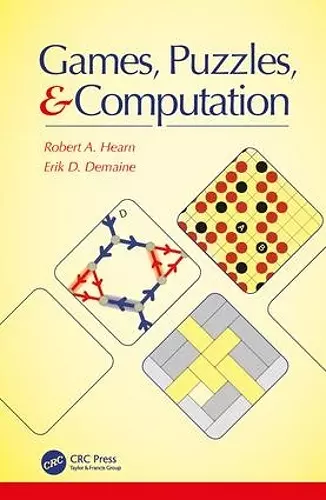Games, Puzzles, and Computation
Erik D Demaine author Robert A Hearn author
Format:Hardback
Publisher:Taylor & Francis Inc
Published:30th Jun '09
Should be back in stock very soon

The authors show that there are underlying mathematical reasons for why games and puzzles are challenging (and perhaps why they are so much fun). They also show that games and puzzles can serve as powerful models of computation—quite different from the usual models of automata and circuits—offering a new way of thinking about computation. The appendices provide a substantial survey of all known results in the field of game complexity, serving as a reference guide for readers interested in the computational complexity of particular games, or interested in open problems about such complexities.
"… the games also provide an extremely well-suited platform for the introduction of a unified method for determining complexity using constraint logic … considers not only mathematically oriented games, but also games that may well be suitable for non-mathematicians … The book also contains a comprehensive overview of known results on the complexity of games and therefore with its 177 references is also an excellent reference book on the topic … warmly recommended for anyone who likes games and wants to know more about their (mathematical) complexity."
—Internaionale Mathematische Nachrichten, December 2012
"Games, Puzzles, and Computation will serve well in roles similar to that of Garey and Johnson’s book. In particular, the text would work exceedingly well as a reference for what’s known in the subfield of game/puzzle complexity or for self-study by someone familiar with basic computational complexity principles who is interested in learning more about the complexity of games and puzzles. It would also serve well as supplementary material to an upper-level undergraduate or entry-level graduate special topics course in game/puzzle complexity. It could also be used as the primary text for such a course (in principle) given extra preparation by the instructor … ."
—Daniel Apon, SIGACT News, September 2011
"The authors show that there are underlying mathematical reasons that games and puzzles are challenging (which perhaps explains why they are so much fun). Complementarily, they also show that games and puzzles can serve as powerful models of computation — quite different from the usual models of automata and circuits — offering a new way of thinking about computation."
—L'Enseignement Mathematique, December 2009
"… intriguing book … Hearn and Demaine present an elegant family of benchmarks they have developed, allowing them to settle open questions on the complexity of various games. … and the authors certainly provide plenty to mull over. The publisher A K Peters has done a quite nice job of production, as well. All in all, this is a book well worth looking into."
—Leon Harkleroad, MAA Reviews, December 2009
"This book will be of interest to advanced readers working in this area."
—Brian Borchers, CHOICE, February 2010
"… the games also provide an extremely well-suited platform for the introduction of a unified method for determining complexity using constraint logic … considers not only mathematically oriented games, but also games that may well be suitable for non-mathematicians … The book also contains a comprehensive overview of known results on the complexity of games and therefore with its 177 references is also an excellent reference book on the topic … warmly recommended for anyone who likes games and wants to know more about their (mathematical) complexity."
—Internaionale Mathematische Nachrichten, December 2012
"Games, Puzzles, and Computation will serve well in roles similar to that of Garey and Johnson’s book. In particular, the text would work exceedingly well as a reference for what’s known in the subfield of game/puzzle complexity or for self-study by someone familiar with basic computational complexity principles who is interested in learning more about the complexity of games and puzzles. It would also serve well as supplementary material to an upper-level undergraduate or entry-level graduate special topics course in game/puzzle complexity. It could also be used as the primary text for such a course (in principle) given extra preparation by the instructor … ."
—Daniel Apon, SIGACT News, September 2011
"The authors show that there are underlying mathematical reasons that games and puzzles are challenging (which perhaps explains why they are so much fun). Complementarily, they also show that games and puzzles can serve as powerful models of computation — quite different from the usual models of automata and circuits — offering a new way of thinking about computation."
—L'Enseignement Mathematique, December 2009
"… intriguing book … Hearn and Demaine present an elegant family of benchmarks they have developed, allowing them to settle open questions on the complexity of various games. … and the authors certainly provide plenty to mull over. The publisher A K Peters has done a quite nice job of production, as well. All in all, this is a book well worth looking into."
—Leon Harkleroad, MAA Reviews, December 2009
"This book will be of interest to advanced readers working in this area."
—Brian Borchers, CHOICE, February 2010
ISBN: 9781568813226
Dimensions: unknown
Weight: 544g
248 pages